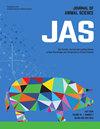Effects of unconventional diets and unconventional low-protein diets on reproductive performance, placental nutrient transport and fecal microorganisms of multiparous sows during gestation.
IF 2.7
2区 农林科学
Q1 AGRICULTURE, DAIRY & ANIMAL SCIENCE
引用次数: 0
Abstract
The objective of this experiment was to investigate the effects of unconventional ingredients (wheat, broken rice, rapeseed meal, rice bran meal, and fermented distiller grains) into sow diets on sow reproductive performance, placental nutrient transport function, and fecal microbiota. Thirty multiparous sows with similar parity and backfat thickness were randomly assigned to three groups: corn-soybean meal diet (CG), unconventional diet (DY), and unconventional low-protein diet (DYL). The DYL group had 2% lower crude protein than CG and DY. Sows were fed experimental diets during gestation and a corn-soybean meal diet during lactation. Results showed that unconventional ingredients did not negatively affect sow reproductive performance. Compared to the CG treatment, the DY treatment showed a trend of increasing the weaned litter weight (P = 0.061). Compared to the DY treatment, the DYL treatment showed a trend of reducing the number of mummified fetuses (P = 0.066) and increasing the number of weaned piglets (P = 0.096). Additionally, unconventional ingredients enhanced placental nutrient transport gene expression (P < 0.05) and fecal butyric acid content (P < 0.05). Compared to the CG treatment, the DY treatment reduced the apparent digestibility of organic matter, energy, crude protein, and crude fiber but increased the digestibility of crude fat (P < 0.05). In terms of inflammatory factors, the DYL treatment significantly decreased the serum IL-6 content in sows at 90 and 110 days of gestation (P < 0.05). In terms of fecal microbiota, the DY treatment significantly increased the Observed_features and Chao1 indices (P < 0.05), indicating an improvement in fecal microbiota diversity, compared to the CG treatment. At the phylum level, the DYL treatment increased the relative abundance of Proteobacteria. At the genus level, compared to the CG treatment, the DY treatment significantly increased the relative abundance of Anaerovibrio and Ruminococcus, while reducing the relative abundance of Treponema. Additionally, compared to the DY treatment, the DYL treatment significantly increased the relative abundance of Alloprevotella, Prevotella, and Parabacteroides. In summary, replacing corn and soybean meal with unconventional ingredients and reducing protein levels during gestation did not adversely affect sow reproductive performance. During periods of significant price fluctuations in corn and soybean meal, incorporating unconventional ingredients into feed formulations can serve as an alternative solution.求助全文
约1分钟内获得全文
求助全文
来源期刊

Journal of animal science
农林科学-奶制品与动物科学
CiteScore
4.80
自引率
12.10%
发文量
1589
审稿时长
3 months
期刊介绍:
The Journal of Animal Science (JAS) is the premier journal for animal science and serves as the leading source of new knowledge and perspective in this area. JAS publishes more than 500 fully reviewed research articles, invited reviews, technical notes, and letters to the editor each year.
Articles published in JAS encompass a broad range of research topics in animal production and fundamental aspects of genetics, nutrition, physiology, and preparation and utilization of animal products. Articles typically report research with beef cattle, companion animals, goats, horses, pigs, and sheep; however, studies involving other farm animals, aquatic and wildlife species, and laboratory animal species that address fundamental questions related to livestock and companion animal biology will be considered for publication.
 求助内容:
求助内容: 应助结果提醒方式:
应助结果提醒方式:


